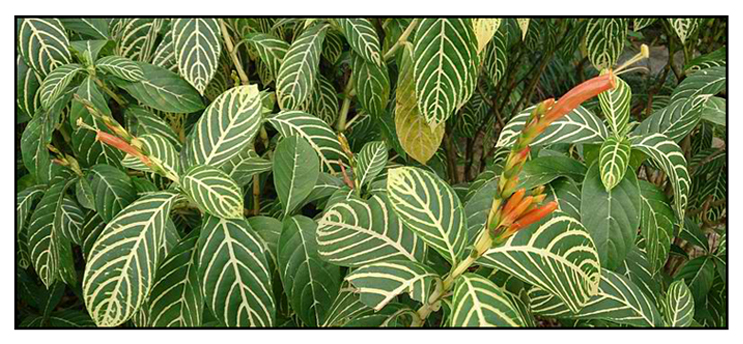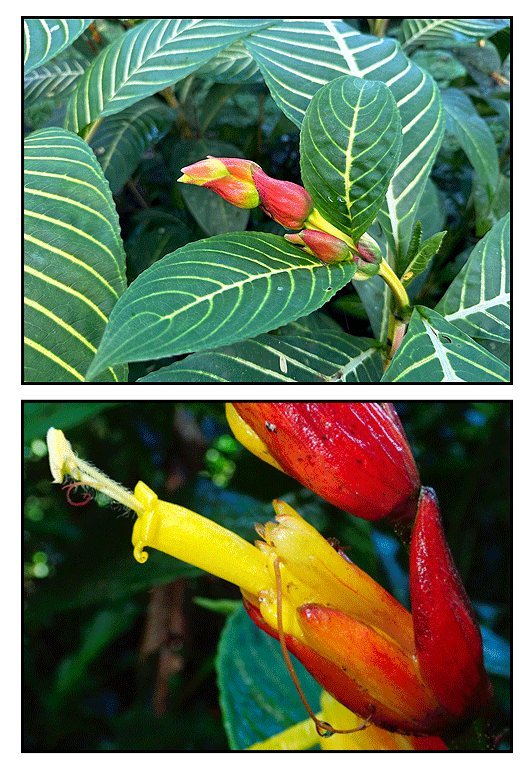
Family • Acanthaceae
Sanchezia
Sanchezia oblonga Ruiz & Pav.
YELLOW SANCHEZIA / SHRUBBY WHITEVEIN
| Scientific names | Common names |
| Ancylogyne peruviana Nees | Sanchezia (Local name) |
| Sanchezia bicolor Leonard& L.B.Sm. | Large-bract sanchezia (Engl.) |
| Sanchezia flava Leonard | Shrubby whitevein (Engl.) |
| Sanchezia glaucophylla T.Moore & Mast. | Yellow sanchezia (Engl.) |
| Sanchezia helophila Leonard & L.B.Sm. | Zebra plant (Engl.) |
| Sanchezia macbridei Leonard | |
| Sanchezia megalia Leonard & L.B.Sm. | |
| Sanchezia nobilis Hook.f. | |
| Sanchezia nobilis var. glaucophylla Lem. | |
| Sanchezia nobilis var. variegata B.S.Williams | |
| Sanchezia oblonga Ruiz & Pav. | |
| Sanchezia peruviana (Nees) Rusby | |
| Sanchezia speciosa Leonard | |
| Sanchezia speciosa Leonard is a synonym of Sanchezia oblonga. | |
| Sanchezia oblonga is an accepted species. KEW: Plants of the World Online | |
| Other vernacular names |
| COLUMBIA: Sombra. |
| FRENCH: Sanchezie. |
| PORTUGUESE: Sanquesia. |
| SPANISH: Cachimbo amarillo, Sanchesia. |
• Stem - smooth bright green or purple stems. Leaves - simple, opposite, large variegated, blade oblong to elliptic, 10-40 cm long, green or with yellow veins. Fruit a narrowly cylindrical capsule, infrequently formed in cultivation Flower - flowers several, borne in clusters on an erect terminal spike sometimes divided at the base, with an ovate orange to red bract below each flower cluster. Corolla of fused petals, tubular, 4.5-5.5 cm long with five short, rounded lobes, yellow to orange, bearing oblanceolate orange sepals half as long, two protruding stamens, continuously through the year; .Fruit - a narrowly cylindrical capsule, infrequently formed in cultivation. (13)
Constituents Properties Studies Availability |
© Godofredo U. Stuart Jr., M.D. |
Updated October 2025 / October 2019 / December 2017
June 2015
![]()
 |
PHOTOS / ILLUSTRATIONS |
| IMAGE SOURCE: Shrubby Whitevein (Sanchezia speciosa) 5.jpg Mokkie / 25 Feb 2014 / Creative CommonsAttribution-Share Alike 3.0 Unported license./ click on image to go to source page / Wikimedia Commons |
| OTHER IMAGE SOURCE: Shrubby Whitevein (Sanchezia oblonga) / © Nolan Exe / Some rights reserved / CC BY 4.0 International Deed / Click on image or link to go to source page / iNaturalist |
| OTHER IMAGE SOURCE: Shrubby Whitevein (Sanchezia oblonga) / © Silviagu / Some rights reserved / CC BY-NC 4.0 // Click on image or link to go to source page / iNaturalist |
Additional
Sources and Suggested Readings |
• |
DOI: It is not uncommon for links on studies/sources to change. Copying and pasting the information on the search window or using the DOI (if available) will often redirect to the new link page. (Citing and Using a (DOI) Digital Object Identifier) |
| List of Understudied Philippine Medicinal Plants |
| New plant names needed The compilation now numbers over 1,500 medicinal plants. While I believe there are hundreds more that can be added to the collection, they are becoming more difficult to find. If you have a plant to suggest for inclusion, native or introduced, please email the info: scientific name (most helpful), local plant name (if known), any known folkloric medicinal use, and, if possible, a photo. Your help will be greatly appreciated. |
• |
 |

 Gen info
Gen info Distribution
Distribution